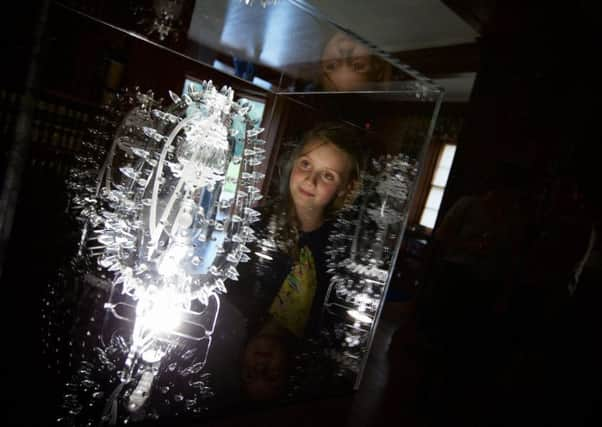Review: Findhorn Bay Festival


As well as nerve, the festival’s scale and range indicates a lot of ambition, and bigger things to come. Launched in 2014, it’s a biennial event, with music, theatre, dance, visual art, and a substantial number of talks, tours, and family events. It opened last Wednesday with Julie Fowlis, in Forres (accompanied by Nairn Gaelic Choir), and closes tonight with Scottish Opera’s The Elixir of Love, in Elgin. There are significant local companies involved, such as Dudendance, based in Aberdeenshire, who staged their installation The Lady Vanishes at dawn and dusk over the weekend (for the dedicated festival-goer this meant a 6.45am trip to Kinloss Abbey) and Wildbird, based in Moray, who illuminated windows around Forres on Friday and Saturday night with digital snapshots of people’s lives.
My three-day visit began with Pulse by Mairi Campbell, a mesmerising performer with such a gift for accents and physical comedy that it’s easy to forget her main job is folk musician. Her theatre debut, an exhilarating blend of music, movement and animation, tells the true story of how a Scottish islander finally found her musical ‘pulse’, after frustrating detours to Guildhall School of Music in London and a Mexican orchestra, before a visit to Cape Breton turned things around. It’s a perfect show for this festival, more intimate and resonant in the tiny James Milne Institute in Findhorn than in the Central Belt venues where it’s previously been staged. Afterwards, you could step out of the venue straight onto the beach and contemplate the dark ocean as the story swam around your head. Or you could return inside for a raffle ticket, a drink, and more songs.
Advertisement
Hide AdAdvertisement
Hide AdI ran into Campbell the following afternoon and we chatted for a while about the history of step-dancing. Findhorn is that kind of festival – don’t perform there if you don’t want to mingle with your audience, and possibly be roped into a jam session and/or late night drinking.
That day, Campbell and I were both off to see Drift, a theatre installation on Findhorn beach, by Edinburgh-based Vision Mechanics. Like Pulse, it’s a true story of a woman’s epic international journey, in this case Betty Mouat, a 19th century Shetland crofter cast adrift at sea and, miraculously, rescued on the coast of Norway nine days later. It’s told through songs and sound-scapes that you listen to while wandering around a series of wooden beach sculptures, whose relationship to the text becomes less clear as Betty begins to lose her grip on reality. Drift has been praised elsewhere but I found it repetitive and lacking tension or drama. Perhaps that’s the point, that Betty’s ocean ordeal was just another thing to be endured in a difficult life – this is a woman who also survived being accidentally shot and run over by a cart – but after a while I drifted off myself.
I can see why the festival programmed it though. Drift is a show rooted in the north of Scotland, by artists who have won acclaim much more widely (it was shortlisted for three CATS Awards). But here’s a thought prompted by my disappointment - it would be nice if Findhorn 2018 could commission a new piece that ticks those boxes rather than having to buy something in.
I felt the same, later on Friday, about Jungle Book, by Yorkshire-based Indigo Moon Theatre, a charming but superficial retelling of Rudyard Kipling’s famous story that, despite its impressive puppetry, shadow theatre and digital projections, felt like a sideshow in a festival with such artistic ambition. Scotland has some of the best children’s theatre in the world; was nobody available? Shona Reppe, perhaps, who reinvents classic tales with far more wit and sophistication? However my three-year-old seemed to like it, and Forres Town Hall was packed.
In the end, though, the heart of the festival was not in any individual show but Culture Day Forres on Saturday, a big and well attended five-hour programme of live music, street theatre, installations, stalls, workshops, and fun little hidden installations, with so much going on that it often crashed into itself gloriously. My enduring memory of Findhorn Bay Festival will be watching a man singing Johnny Cash songs being jumped on by a group of excitable Vikings, while fish in welly boots danced past, as I ate ‘depressed cakes’ with grey icing (courtesy of Moray Wellbeing Hub) and helped my daughter build a mobile. That alone could be enough to tempt me back in 2018.